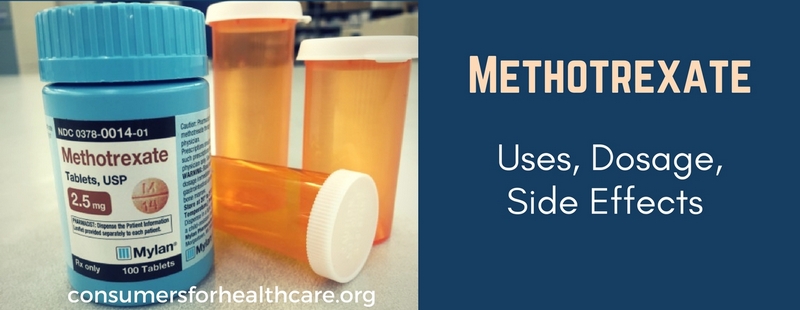Methotrexate: Indications, Dosage, Side Effects and More
 Methotrexate is an antineoplastic, cytostatic agent of the antimetabolite group, inhibits dihydrofolate reductase, which participates in the reduction of dihydrofolic acid into tetrahydrofolic acid (a carrier of carbon fragments necessary for the synthesis of purine nucleotides and their derivatives).
Methotrexate is an antineoplastic, cytostatic agent of the antimetabolite group, inhibits dihydrofolate reductase, which participates in the reduction of dihydrofolic acid into tetrahydrofolic acid (a carrier of carbon fragments necessary for the synthesis of purine nucleotides and their derivatives).
Composition: Methotrexate and auxiliary ingredients
Indications and dosage
- trophoblastic tumors;
- acute leukemia (lymphoblastic and myeloblast variants);
- neuroleukemia;
- lymphomas, including lymphosarcomas;
- breast cancer, squamous cell carcinoma of the head and neck, lung cancer, skin cancer, cervical cancer, vulvar cancer, esophageal cancer, kidney cancer,
- bladder cancer, testicular cancer, ovarian cancer, penile cancer, retinoblastoma, medulloblastoma;
- osteogenic sarcoma and soft tissue sarcomas;
- mushroom-like mycosis (far advanced stages);
- severe forms of psoriasis, psoriatic arthritis, rheumatoid arthritis, dermatomyositis, systemic lupus erythematosus, spondylitis (with ineffective standard therapy).
Methotrexate is part of many chemotherapy treatmen programs, therefore, when choosing the route of administration, regimen and dosage in each individual case, you should consult a doctor or refer to the special literature.
Methotrexate tablets are taken orally before meals without chewing.
Overdose
In case of accidental overdose of methotrexate, it is recommended to use a specific antidote – calcium folinate. Introduction of Calcium folinate should be started as soon as possible, preferably within the first hour, at a dose equal to or greater than the dose of methotrexate; subsequent doses are administered as needed depending on the concentration of methotrexate in the blood serum. To prevent precipitation of methotrexate and / or its metabolites in the renal tubules, a patient needs hydration of the body.
Side effects
- Hemopoiesis: leukopenia, neutropenia, lymphopenia (especially T-lymphocytes), thrombocytopenia, anemia;
- Digestive system: anorexia, nausea, vomiting, stomatitis, gingivitis, glossitis, pharyngitis, rarely – enteritis, diarrhea, erosive and ulcerative lesions and bleeding;
- Gastrointestinal tract, in some cases (with prolonged daily use) , increased activity of “liver” transaminases, periportal fibrosis and cirrhosis of the liver, liver necrosis, fatty liver, pancreatitis;
- Nervous system: encephalopathy, especially at multiple doses. There are also reports of fatigue, weakness, confusion, ataxia, tremor, irritation, convulsions and coma. Acute side effects of methotrexate may include dizziness, blurred vision, headache, back pain, stiff neck, convulsions, paralysis, hemiparesis;
- Respiratory system: rarely – interstitial pneumonitis, pulmonary fibrosis, exacerbation of pulmonary infections;
- Urinary system: cystitis, nephropathy, impaired renal function (increased levels of creatinine, hematuria);
- Reproductive system: violation of the process of oogenesis, spermatogenesis, decreased libido / impotence, changes in fertility, teratogenic effects;
- Skin and skin appendages: cutaneous erythema and / or rash, skin itching, urticaria, telangiectasia, furunculosis, depigmentation or hyperpigmentation, acne, skin peeling, folliculitis, alopecia (rarely), increased photosensitivity, exacerbation of radiation dermatitis;
- Sense organs: conjunctivitis, excessive lacrimation, cataract, photophobia, cortical blindness (at high doses), visual impairment;
- Allergic reactions: fever, chills, rashes, hives, anaphylaxis, malignant exudative erythema (Stevens-Johnson syndrome), toxic epidermal necrolysis (Lyell’s syndrome).
- Other: immunosuppression (reduced resistance to infectious diseases), malaise, osteoporosis, hyperuricemia, vasculitis, arthralgia / myalgia.
Contraindications
- Hypersensitivity to methotrexate and / or any other component of the drug;
- Severe anemia, leukopenia, neutropenia, thrombocytopenia;
- Renal or hepatic insufficiency;
- Pregnancy and lactation.
Interaction with other medicines and alcohol
The simultaneous use of high doses of methotrexate with various non-steroidal anti-inflammatory drugs (NSAIDs), including aspirin and other salicylates, azaprene, diclofenac, indomethacin and ketoprofen, may increase toxicity of methotrexate, in some cases severe toxic effects are possible, sometimes even fatal. With special precautions and appropriate monitoring, the use of methotrexate in low doses (7.5-15 mg per week) in the treatment of rheumatoid arthritis, in combination with NSAIDs is not contraindicated. The simultaneous use of sulfonamides, derivatives of sulfonylurea, phenytoin, phenylbutazone, aminobenzoic acid, probenicid, pyrimethamine or trimethoprim, a number of antibiotics (penicillin, tetracycline, chloramphenicol), indirect anticoagulants and lipid-lowering drugs (cholestyramine) increases the toxicity of methotrexate. Antibiotics, poorly absorbed in the digestive tract (tetracyclines, chloramphenicol), reduce the absorption of methotrexate and disrupt its metabolism due to suppression of normal intestinal microflora.
Pharmachologic effect
Antineoplastic, cytostatic agent of the group of antimetabolites-analogues of folic acid. It inhibits dihydrofolate reductase involved in the reduction of dihydrofolic acid into tetrahydrofolic acid (a carrier of carbon fragments necessary for the synthesis of purine nucleotides and their derivatives).
It inhibits synthesis, DNA repair and cellular mitosis (in the S phase). Tissue with high cell proliferation is especially sensitive to the action of methotrexate: tumor tissue, bone marrow, epithelial cells of the mucous membranes, embryonic cells. In addition, methotrexate has immunosuppressive properties.
In addition, methotrexate has an immunosuppressive effect.
